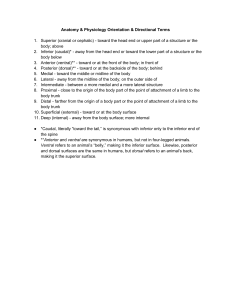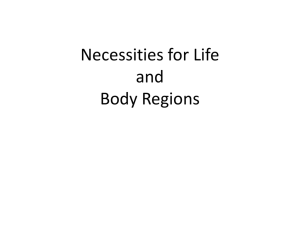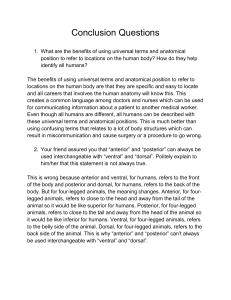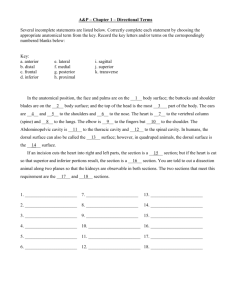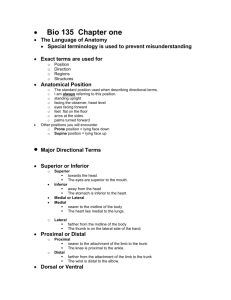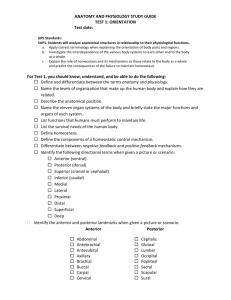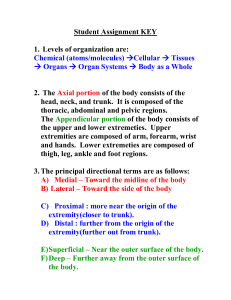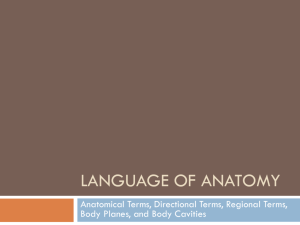Anatomy & Physiology Study Guide - Unit 1
advertisement
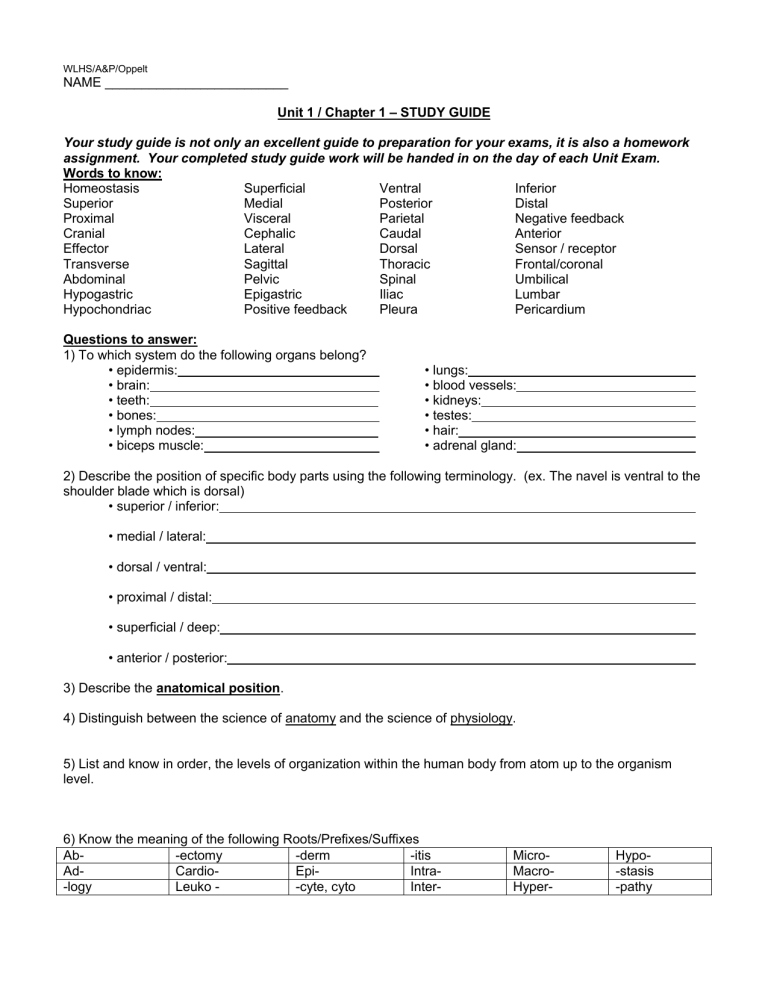
WLHS/A&P/Oppelt NAME _________________________ Unit 1 / Chapter 1 – STUDY GUIDE Your study guide is not only an excellent guide to preparation for your exams, it is also a homework assignment. Your completed study guide work will be handed in on the day of each Unit Exam. Words to know: Homeostasis Superficial Ventral Inferior Superior Medial Posterior Distal Proximal Visceral Parietal Negative feedback Cranial Cephalic Caudal Anterior Effector Lateral Dorsal Sensor / receptor Transverse Sagittal Thoracic Frontal/coronal Abdominal Pelvic Spinal Umbilical Hypogastric Epigastric Iliac Lumbar Hypochondriac Positive feedback Pleura Pericardium Questions to answer: 1) To which system do the following organs belong? • epidermis: • brain: • teeth: • bones: • lymph nodes: • biceps muscle: • lungs: • blood vessels: • kidneys: • testes: • hair: • adrenal gland: 2) Describe the position of specific body parts using the following terminology. (ex. The navel is ventral to the shoulder blade which is dorsal) • superior / inferior: • medial / lateral: • dorsal / ventral: • proximal / distal: • superficial / deep: • anterior / posterior: 3) Describe the anatomical position. 4) Distinguish between the science of anatomy and the science of physiology. 5) List and know in order, the levels of organization within the human body from atom up to the organism level. 6) Know the meaning of the following Roots/Prefixes/Suffixes Ab-ectomy -derm -itis AdCardioEpiIntra-logy Leuko -cyte, cyto Inter- MicroMacroHyper- Hypo-stasis -pathy 7) Using your knowledge of root words, decipher the meaning of the following terms: • leukocyte: • intracellular: • dermatitis: • intercellular: • tonsillectomy: • cardiology: 8) What are the 5 characteristics of life? _____________________________ _____________________________ _____________________________ _____________________________ _____________________________ 9) Describe the following types of membranes found in the thoracic cavity. a. Parietal Pleura: _________________________________________________________________ b. Visceral Pleura: _________________________________________________________________ c. Pleural Cavity:___________________________________________________________________ 10) What are the 3 components to a feedback system? _____________________ _____________________ _____________________ 11) What is a negative feedback loop? Give an example. 12) What is a positive feedback loop? Give an example. 13) Using the word bank below, indicate the body systems that match the following descriptions. Cardiovascular Digestive Endocrine ________________________ ________________________ ________________________ ________________________ ________________________ ________________________ ________________________ ________________________ ________________________ ________________________ ________________________ ________________________ ________________________ ________________________ ________________________ Integumentary Lymphatic Muscular Nervous Reproductive Respiratory Skeletal Urinary a. Rids the body of nitrogen-containing wastes b. Is affected by removal of the adrenal gland c. Protects and supports organs; provides a framework for muscular action d. Includes arteries and veins e. Controls the body by means of chemicals called hormones f. External body coverings g. House cells that involve the body immunity i. Breaks down ingested food into its absorbable units j. Loads oxygen into the blood k. Uses blood as a transport as transport vehicle l. Generates body heat and provides locomotion of the body as a vehicle m. Regulates water and acid-base balance of blood n. Is damaged when you fall and scrape your knee o. necessary for childbearing p. also necessary for childbearing (second answer) 14) In appendicitis, pain may be experienced in the lower portion of what gross abdominopelvic region? A) epigastric B) right iliac C) left iliac D) umbilical E) right lumbar 15) If you were asked to rub ointment on the anterior surface of the thigh, you would apply it to the _____ of the thigh? A) front B) back 16) What position does the tongue occupy with respect to the palate (roof of the mouth)? A) anterior B) posterior C) inferior D) superior E) lateral 17) Using the diagram to the right, identify the body cavities and include the diaphragm. A A) _________________________________ B) _________________________________ B C) _________________________________ C D) _________________________________ E) _________________________________ D F) _________________________________ F 18) Using the diagram below, identify the 9 abdominal regions of the abdomen. E 19) Be able to identify the various regions of the body using the correct terminology in the diagram below. 20) a. A nurse informed John that she was about to take blood from his antecubital region. What part of his body was the nurse referring? _____________________________________ b. Later, the nurse came back and said that she was going to give him an antibiotic shot in his deltoid region. What article of clothing would John have to remove for the shot; his pants or his shirt? ____________ c. Before John left the office, the nurse noticed that his left sural region was badly bruised. What part of his body was black and blue? ________________________ 21) Explain how scratching an itch is an example of negative feedback response.

